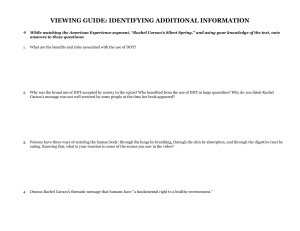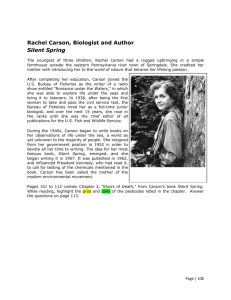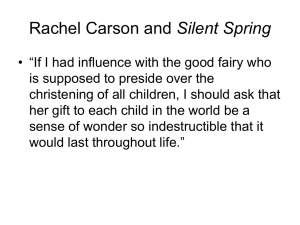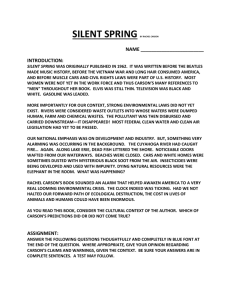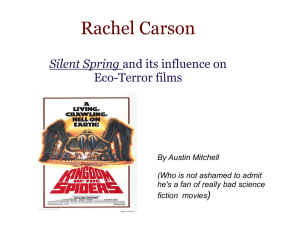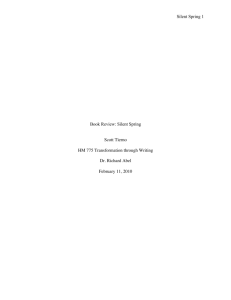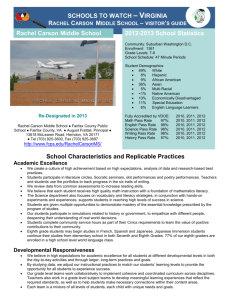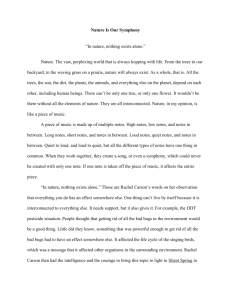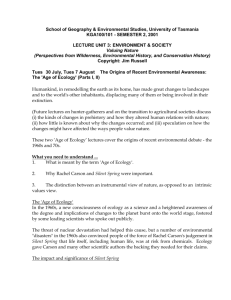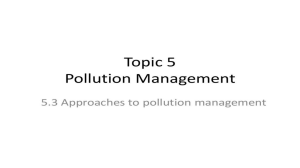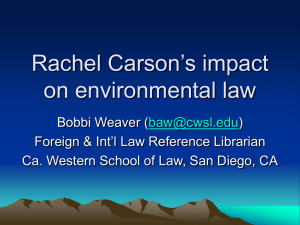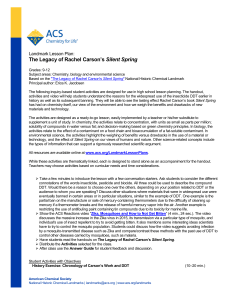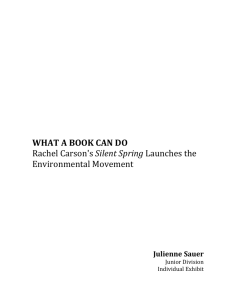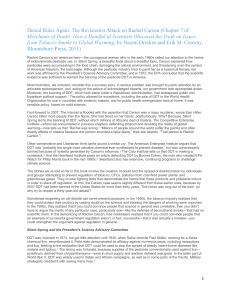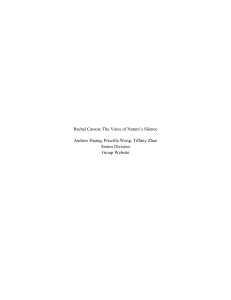Silent Spring - Harrison Township
advertisement
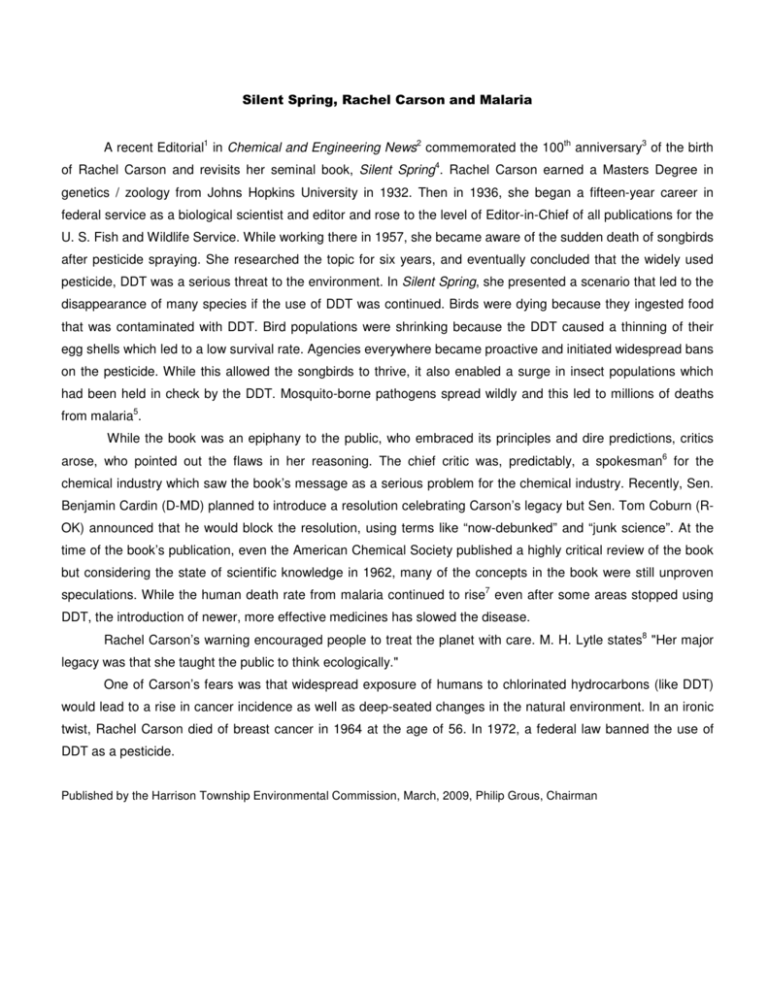
A recent Editorial1 in Chemical and Engineering News2 commemorated the 100th anniversary3 of the birth of Rachel Carson and revisits her seminal book, Silent Spring4. Rachel Carson earned a Masters Degree in genetics / zoology from Johns Hopkins University in 1932. Then in 1936, she began a fifteen-year career in federal service as a biological scientist and editor and rose to the level of Editor-in-Chief of all publications for the U. S. Fish and Wildlife Service. While working there in 1957, she became aware of the sudden death of songbirds after pesticide spraying. She researched the topic for six years, and eventually concluded that the widely used pesticide, DDT was a serious threat to the environment. In Silent Spring, she presented a scenario that led to the disappearance of many species if the use of DDT was continued. Birds were dying because they ingested food that was contaminated with DDT. Bird populations were shrinking because the DDT caused a thinning of their egg shells which led to a low survival rate. Agencies everywhere became proactive and initiated widespread bans on the pesticide. While this allowed the songbirds to thrive, it also enabled a surge in insect populations which had been held in check by the DDT. Mosquito-borne pathogens spread wildly and this led to millions of deaths from malaria5. While the book was an epiphany to the public, who embraced its principles and dire predictions, critics arose, who pointed out the flaws in her reasoning. The chief critic was, predictably, a spokesman6 for the chemical industry which saw the book’s message as a serious problem for the chemical industry. Recently, Sen. Benjamin Cardin (D-MD) planned to introduce a resolution celebrating Carson’s legacy but Sen. Tom Coburn (ROK) announced that he would block the resolution, using terms like “now-debunked” and “junk science”. At the time of the book’s publication, even the American Chemical Society published a highly critical review of the book but considering the state of scientific knowledge in 1962, many of the concepts in the book were still unproven speculations. While the human death rate from malaria continued to rise7 even after some areas stopped using DDT, the introduction of newer, more effective medicines has slowed the disease. Rachel Carson’s warning encouraged people to treat the planet with care. M. H. Lytle states8 "Her major legacy was that she taught the public to think ecologically." One of Carson’s fears was that widespread exposure of humans to chlorinated hydrocarbons (like DDT) would lead to a rise in cancer incidence as well as deep-seated changes in the natural environment. In an ironic twist, Rachel Carson died of breast cancer in 1964 at the age of 56. In 1972, a federal law banned the use of DDT as a pesticide. Published by the Harrison Township Environmental Commission, March, 2009, Philip Grous, Chairman Footnotes 1 Chemical and Engineering News (C&EN), June 4, 2007, p 5 2 Chemical and Engineering News is the weekly publication of the American Chemical Society (ACS), a professional organization representing the interests of >150,000 chemists and chemical engineers worldwide. The magazine regularly reports on issues in Government, Science, Business and ACS matters. 3 May 27, 2007 4 Boston: Houghton Mifflin, 1962 5 World Health Organization, World Health Report 2005 “At least one million deaths occur every year due to malaria.” 6 Dr. Robert White-Stevens, a former biochemist and assistant director of the Agricultural Research Division of American Cyanamid 7 This was due to bioaccumulation in the food sources and persistence in the environment. 8 The Gentle Subversive: Rachel Carson, Silent Spring, and the Rise of the Environmental Movement by Mark H. Lytle, Oxford University Press US, 2007 Other resources For those who would like to explore the thoughts of Rachel Carson and Silent Spring, in addition to reference 8 above, here are a few links for more information: http://www.rachelcarson.org/ http://www.time.com/time/time100/scientist/profile/carson.html http://www.nrdc.org/health/pesticides/hcarson.asp For a debate on the appropriateness of using or banning DDT for pest control see: http://www.alternet.org/environment/15599 http://www.jennifermarohasy.com/articles.php?id=54 http://www.salon.com/news/feature/2007/06/29/rachel_carson/index1.html Important public health websites: http://www.cdc.gov/ US Centers for Disease Control http://www.who.int/en/ World Health Organization http://www.apha.org/ American Public Health Association http://www.medicalnewstoday.com/sections/public_health/ Medical News Today http://www.usphs.gov/ US Department of Health and Human Services Time line for malaria 1847 DDT was first synthesized by Othmer Zeidler in Germany 1897 Mosquito identified as vector for malaria by Ronald Ross 1907 Rachel Carson was born on May 27 1939 The insecticidal property of DDT was discovered by Paul Müller in Switzerland (Geigy Co.) 1962 Silent Spring was published 1964 Rachel Carson died of breast cancer 1972 A federal law banned the use of DDT
